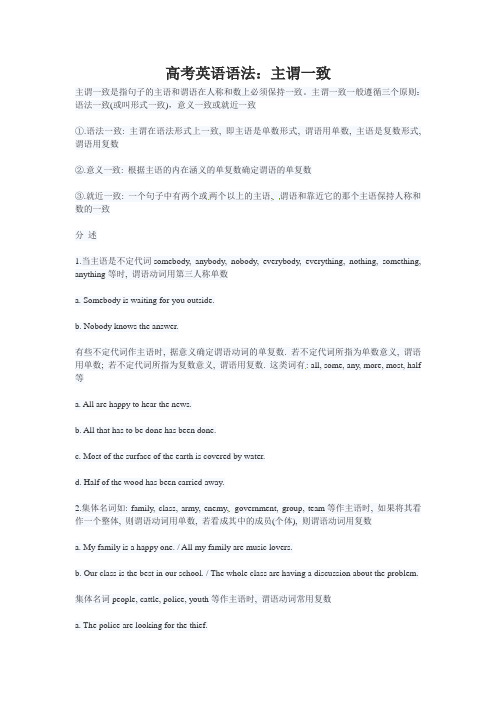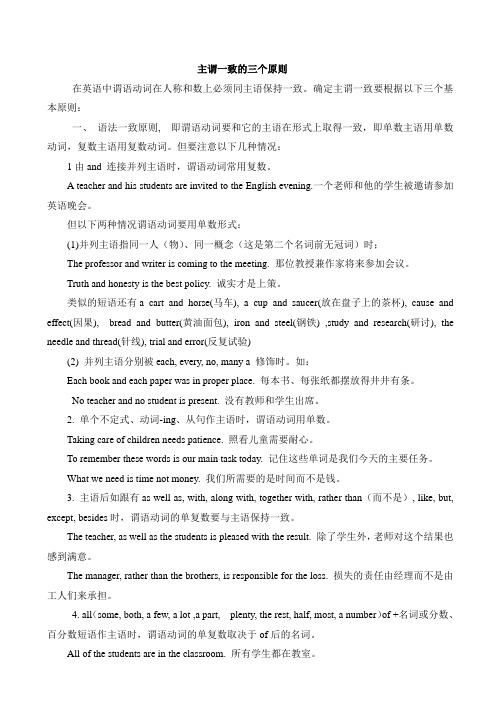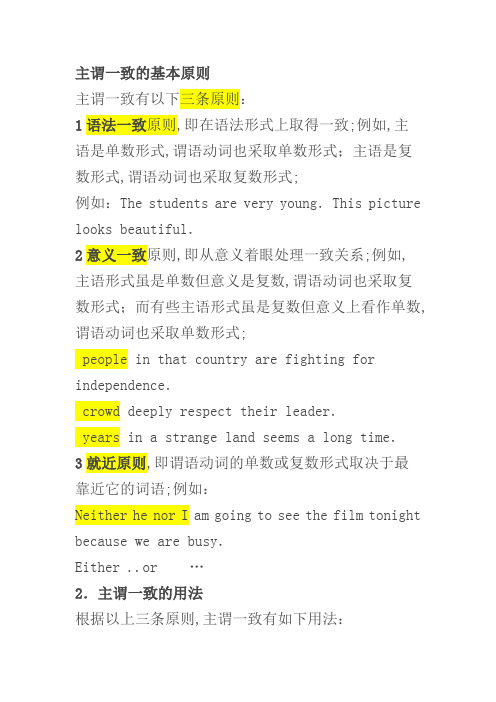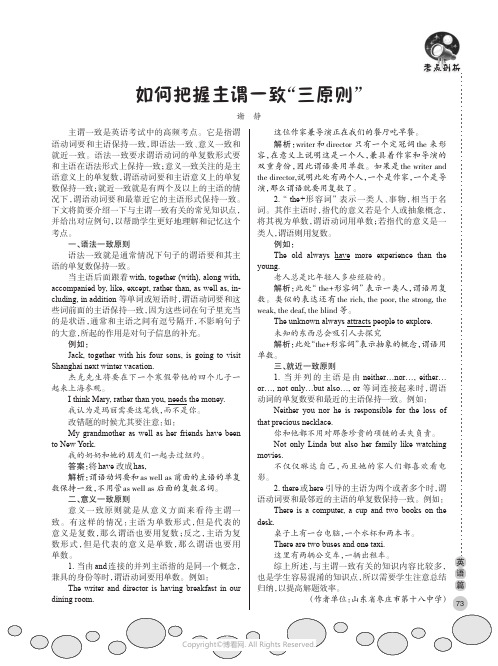主谓一致三原则
主谓一致“三原则”

主谓一致“三原则”一、语法一致原则。
即主语和谓语的语法形式在人称和数上取得一致,谓语的单复数形式取决于主语的单复数形式。
1.主语为复数时用复数的谓语动词;主语为单数名词、代词、不可数名词、单个的动词不定式、动名词短语或从句时,谓语动词用单数。
2. 由and或both…and连接的短语,谓语动词常用复数。
3.and连接的两个名词指同一人、同一物或同一概念时,谓语动词用单数。
4.由and连接的两个单数主语前分别有every, each, many a, no修饰时,谓语动词用单数。
5.主语为单数,尽管后面跟有with, together with, along with, as well as, not,besides, like, except, but, including, rather than 等引起的短语,谓语动词仍用单数。
二、意义一致原则。
即谓语动词取决于主语所表达的意义,若主语形式上为复数,而意义上是单数,动词要用单数;若主语形式上为单数,而意义上是复数,动词要用复数;1. 表示时间、距离、价格、长度、重量的复数名词常被看作一个整体,谓语动词用单数。
2. family, team, crowd, audience, class, committee 等集合名词作主语时,如看成一个整体,谓语动词用单数,如看成若干成员,谓语动词用复数。
3. the rest, some, most, half, part, 分数或百分数作主语时,所指代的是可数名词,谓语用复数;指代的是不可数名词,谓语用单数。
4. either, neither, each, another以及any, some, no, every与body, one, thing构成的不定代词作主语时谓语动词用单数。
5.none of 作主语时,后接不可数名词用单数的谓语动词;后接可数名词时,谓语动词既可用单数也可用复数。
5. the加上形容词或分词可当名词来用,如指一类人,用复数的谓语动词;如指一抽象概念,则用单数的谓语动词。
淡谈主谓一致的三个原则

淡谈主谓一致的三个原则仙桃市实验高中付荣主谓一致是指谓语动词与主语在人称和数上保持一致。
一般来说主谓一致遵循三个原则,即:语法一致,意义一致和就近原则。
一、语法一致:主语和谓语在语法形式上保持一致1、and连接两个或两个以上单数名词或代词作主语的时候,谓语动词有以下两种说法:①如果指两个或两个以上不同的人或事物的时候,谓语动词用复数。
He and I are both students of this school.②如果连接两个以上的名词指的是同一个人或物,或指同一概念的时候,谓语要用单数。
The singer and dancer is going to give us a performance.那个歌唱家兼舞蹈演员要给我们表演。
The knife and fork is on the table. 刀刃在桌上。
2、如果主语是单个不定式,单个动词-ing或主语从句的时候,谓语动词用单数。
①What he is doing seems very important.②Collecting stamps is his hobby.3、定语从句的关系代词who, which, that在从句中做主语时,要与先行词人称和数保持一致。
①Those who enjoy singing may join us.②I who am your friend, should help you.③She’s one of the students who were born in Xian tao.④She’s the only one of the students who was born in Beijing.4、主语+介词(短语)with, along with, together with, as well as, besides, like(像) without, except, but, including, rather than谓语以介词(短语)前的主语一致,不受介词后名词的影响。
主谓一致的三个原则

主谓一致的三个原则:语法一致、就近一致、意义一致一.就近一致原则:由or ,nor,either, either …or, neither…nor, not only…but also 等连接的并列主语,谓语动词常和靠近的作主语的名词单复数上保持一致。
Eg:Not only he but also I am invited.Neither my gloves nor my hat goes with the dress. .二.谓语动词和主语保持一致:as much as/no more than/would rather/ rather than /as well as /with/along with /together with/ except /including /but /like/among/besides/ +名词置于主语后,谓语和前面的名词在单复数上保持一致。
Eg:The teacher with a number of students is in the classroom三.谓语动词为单数的情况:1.由and 连接的并列成分指的是同一概念。
Eg: 1. The worker and writer is from Wuhan.那个工人兼作家2. the worker and the writer are from Beijing. 那位工人和那位作家3. Bread and butter is a daily food in the West.2.every… and (every)…,each …and (each… ,no …and (no)… ,many a …and (many a)…连接两个单数名词作主语。
Eg:Every desk and every chair is made of wood.Eg:Many a boy and girl has made the same mistake.。
高考英语语法:主谓一致

高考英语语法:主谓一致主谓一致是指句子的主语和谓语在人称和数上必须保持一致。
主谓一致一般遵循三个原则:语法一致(或叫形式一致),意义一致或就近一致①.语法一致: 主谓在语法形式上一致, 即主语是单数形式, 谓语用单数, 主语是复数形式, 谓语用复数②.意义一致: 根据主语的内在涵义的单复数确定谓语的单复数③.就近一致: 一个句子中有两个或两个以上的主语,谓语和靠近它的那个主语保持人称和数的一致分述1.当主语是不定代词somebody, anybody, nobody, everybody, everything, nothing, something, anything等时, 谓语动词用第三人称单数a. Somebody is waiting for you outside.b. Nobody knows the answer.有些不定代词作主语时, 据意义确定谓语动词的单复数. 若不定代词所指为单数意义, 谓语用单数; 若不定代词所指为复数意义, 谓语用复数. 这类词有: all, some, any, more, most, half 等a. All are happy to hear the news.b. All that has to be done has been done.c. Most of the surface of the earth is covered by water.d. Half of the wood has been carried away.2.集体名词如: family, class, army, enemy,government, group, team等作主语时, 如果将其看作一个整体, 则谓语动词用单数, 若看成其中的成员(个体), 则谓语动词用复数a. My family is a happy one. / All my family are music lovers.b. Our class is the best in our school. / The whole class are having a discussion about the problem.集体名词people, cattle, police, youth等作主语时, 谓语动词常用复数a. The police are looking for the thief.b. Cattle are not allowed to graze here.3.代词none和neither作主语时, 谓语动词根据说话人的意思用单数或复数. 当说话人着眼于任何一个都不时, 谓语动词用单数; 当说话人着眼于全都不时, 谓语动词用复数a. None of them has a car. ( 他们没有一个人有汽车)b. None of them have a car. ( 他们都没有汽车)c. None of them knows the answer. ( 他们两个谁也不知道答案)d. None of them know the answer. ( 他们两个都不知道答案)4.bothand连接两个主语时, 谓语动词通常用复数. eitheror, neithernor, not onlybut also, notbut 连接两个主语时, 采取就近原则, 即谓语动词和靠近它的那个主语保持一致a. Both Tom and Jerry were late for school that day.b. Either you or he has dropped waste paper in the street.c. Neither he nor I have forgotten for pay for the drinks.5.在There be和Here be结构中, 句子的主语在be之后, 如果主语不止一个, 那么谓语动词be与邻近的主语一致a. There is a desk, a table, three chairs in the room.b. There are three chairs, a desk and a table in the room.c. Here are two letters and a magazine for you.6.如果主语后面跟有with, together with, along with, as well as, but, except, besi des, including, like, rather than, no less than, in addition to(除外)等引导的短语时, 谓语动词的形式只与主语有关, 而与其后的短语无关a. The teacher with three student s was in the classroom then.b. This book, as well as the other two books, is borrowed from our school library.c. None but Jim and Mike knows my secret.d. Seven people, including a policeman, were killed.7.表示时间, 长度, 距离, 金额, 价值, 重量, 容量等的复数名词作主语时, 通常作整体看待, 即表示总量或总和, 谓语动词用单数. 若把它们看作一个个的个体, 即强调其具体数量时, 谓语动词用复数形式a. Twenty years is a long time to us.b. Two hundred miles is not a long distance.c. Ten thousand US dollars is a lot of money.d. There are ten minutes left.8.在四则运算中, 谓语动词用单复数均可, 但单数形式更为多用a. Two and ten is / are twelve.b. Three times five is / are fifteen.9.动名词或动词不定式作主语时, 谓语动词用单数a. Smoking / To smoke is a bad habit.b. Carving animal bones is not an easy job.10.主语从句作主语时, 谓语动词通常用单数. 但若主语从句所指的具体内容为复数意义时, 谓语动词用复数a. What we need is more time.b. What we need are more doctors.11.以-s结尾的专有名词作主语时, 谓语动词通常用单数, 这类专有名词如: General Motors(通用汽车公司), the United Nations(联合国), the United States, the New York Times(纽约时报)等.a. The New York Times is published daily.b. The Arabian Nights is a popular reading among the young people.表示群岛, 山脉, 瀑布的专有名词作主语时, 谓语动词通常用复数, 如:the Andes(安第斯山脉), the Alps(阿尔卑斯山脉), the West Indies(西印度群岛), the Niagara Falls(尼加拉大瀑布)12.有些形式为复数, 而意义为单数的名词作主语时, 谓语动词用单数. 这类名词如: news, works(工厂), politics(政治), physics(物理), mathematics(数学 )等13.以-s或-es结尾, 由对称的两部分构成的物体作主语时, 谓语动词用复数. 这类物体如: trousers, glasses, jeans(牛仔裤), scissors(剪刀), shades(太阳镜)等. 如果这类名词前用了pair, 则谓语动词的数取决于pair的数a. Here is a pair of glasses for you.b. There are three pairs of jeans in the bag.14. 分数或百分数+ of + 名词作主语时, 谓语动词视名词的可数与否采用单数或复数a. Over three quarters of the city was destroyed in the war.b. 35 percent of the do ctors are women.c. Thirty percent of the workers are out of work now.d. One third of the water has been wasted.15.用and连接两个或两个以上的单数名词作主语时, 谓语动词用复数. 如果and连接的两个名词指的是同一人、事、物或概念( 如: a knife and f ork一副刀叉, the bread and butter奶油面包, my house and home我的家)时, 则谓语动词用单数a. Many books and a pen are on the desk.b. The pianist and composer (钢琴家兼作曲家) has come to this small town.16. the + adj.表示一类人或事物作主语时, 谓语动词用复数. the +adj.若表示抽象概念或品质, 则谓语用单数a. The old in the city are taken good care of.b. The beautiful gives pleasure to all of us.美给我们以快乐17.more than one和many a + 单数名词作主语时, 谓语用单数a. Many a student has won the prize.很多学生获了奖b. More than one person has made the same mistake.不止一人犯了同样的错误。
主谓一致的三个原则

主谓一致的三个原则在英语中谓语动词在人称和数上必须同主语保持一致。
确定主谓一致要根据以下三个基本原则:一、语法一致原则, 即谓语动词要和它的主语在形式上取得一致,即单数主语用单数动词,复数主语用复数动词。
但要注意以下几种情况:1由and 连接并列主语时,谓语动词常用复数。
A teacher and his students are invited to the English evening.一个老师和他的学生被邀请参加英语晚会。
但以下两种情况谓语动词要用单数形式:(1)并列主语指同一人(物)、同一概念(这是第二个名词前无冠词)时;The professor and writer is coming to the meeting. 那位教授兼作家将来参加会议。
Truth and honesty is the best policy. 诚实才是上策。
类似的短语还有a cart and horse(马车), a cup and saucer(放在盘子上的茶杯), cause and effect(因果), bread and butter(黄油面包), iron and steel(钢铁) ,study and research(研讨), the needle and thread(针线), trial and error(反复试验)(2) 并列主语分别被each, every, no, many a 修饰时。
如:Each book and each paper was in proper place. 每本书、每张纸都摆放得井井有条。
No teacher and no student is present. 没有教师和学生出席。
2. 单个不定式、动词-ing、从句作主语时,谓语动词用单数。
Taking care of children needs patience. 照看儿童需要耐心。
To remember these words is our main task today. 记住这些单词是我们今天的主要任务。
主谓一致的基本原则

主谓一致的基本原则主谓一致有以下三条原则:1语法一致原则,即在语法形式上取得一致;例如,主语是单数形式,谓语动词也采取单数形式;主语是复数形式,谓语动词也采取复数形式;例如:The students are very young.This picture looks beautiful.2意义一致原则,即从意义着眼处理一致关系;例如,主语形式虽是单数但意义是复数,谓语动词也采取复数形式;而有些主语形式虽是复数但意义上看作单数,谓语动词也采取单数形式;people in that country are fighting for independence.crowd deeply respect their leader.years in a strange land seems a long time.3就近原则,即谓语动词的单数或复数形式取决于最靠近它的词语;例如:Neither he nor I am going to see the film tonight because we are busy.Either ..or …2.主谓一致的用法根据以上三条原则,主谓一致有如下用法:1下列结构作主语,谓语动词一般用单数形式a.表示时间、重量、长度、价值的名词作主语,谓语动词通常用单数形式;例如:hundred miles is a long distance.dollars is a high price for that book.b.由anyone,anything,anybody,noone,nothing,everyone,everybody,everything,some one,somebody,each,either,neither等不定代词作主语,谓语动词使用单数形式;例如:is knocking at the door.is better than going to the movie tonight.c.由“a series of,a kind of,a portion of +名词”作主语,谓语动词应用单数形式;例如:A series of debates is scheduled to be held next week.d.由“many a,more than one +单数名词”作主语,尽管意义上表示复数,但谓语动词仍采用单数形式;例如:Many a person in these circumstances has hoped for a long break.There is more than one answer to your question.e.“名词+and+名词”作主语,表示同一人、同一概念或事物时,谓语动词用单数形式;例如:A writer and educator is giving a lecture now.这个人既是作家又是教育家A writer and a educatorf."either neither + of +复数名词或代词"作主语,谓语动词用单数形式;例如:either of you takes a vacation now,we will not be able to finish the work.of them wants to come.g.在each…and each…,every…and every…等结构之后,谓语动词用单数形式;例如:Each man and each woman has the right to vote.h.动词不定式、动名词或分句作主语时,谓语动词一般用单数形式;例如:What I want to say is none of your business.Listening to the classical music is enjoyable.i.以-ics结尾的复数名词指一门学科时,如politics政治学,mathematics数学,statistics统计学,acoustics声学,linguistics语言学等,谓语动词用单数形式;例如:Mathematics is what he majors in.2下列结构作主语,谓语动词单复数形式取决于of后的名词;意义一致a.由“a11,none,no,most,half,the last,the rest,the remainder+of+名词”等不定代词作主语,谓语动词单复数形式由of后名词的单复数而定;例如:None of the food is wasted.None of the students were absent.The rest of the lecture was dull.The rest of the bikes were on sale yesterday.b.由"lots of,heaps of,loads Of,scads of +名词”作主语,谓语动词单复数形式由of后名词的单复数而定;例如:Lots of work is to be done this week.Lots of people are going to swim this afternoon.There is loads of milk on the farm.There are loads of big red apples on the ground.There is heaps of fun.c.由“分数或百分数十of +名词或代词”作主语,谓语动词的单复数形式取决于of后名词或代词的单复数形式;例如:Three-quarters of the area is cultivated.Ninety percent of the students have passed the exam.3下列结构作主语,谓语动词的单复数形式根据意义而定;a.由“the+形容词” 这种结构作主语,根据意义一致的原则决定谓语动词的单复数形式;如果表示一类人如the rich,the poor,the blind,the deaf,the sick,the young,the old,谓语动词用复数形式;如果表示个人或抽象概念,谓语动词用单数形式;例如:The blind are taught trades in special schools.表示一类人The good in him overweighs the bad.表示抽象概念The departed was a good friend of his.表示个人b.family,crowd,committee,class,audience,group ,government,team,public,majority,minority等集合名词作主语,谓语动词单复数形式应根据意义而定;例如:The family like to listen to the music.the family 指这家人,用作复数The family is small.the family指这个家庭,用作单数The committee has considered your proposal.the committee指委员会,用作单数The committee were arguing for an hour before they gave their votes. the committee指委员会的委员们,用作复数下列结构作主语,谓语动词一般单复数均可;a.以数词为名词词组中心词作主语时,谓语动词一般单复数均可;例如:Five and six make/makes eleven.Seven times ten are seventy.但是:Twenty from thirty leaves ten.Six sevens are forty-two.b.由"one in/out of +名词”作主语,谓语动词单复数均可;例如:One in ten were/was present.下列结构作主语,谓语动词用复数形式;由and或both…and连接两个单数形式的名词词组作主语时,一般谓语动词用复数形式;例如:A girl and a boy want to go.Both rice and wheat are grown in that country.6下列结构作主语,谓语动词单复数形式视具体情况而定;a.由as well as,together with,besides,like,along with,with but,except,accompanied by,rather than,including连接两个名词作主语,谓语单复数形式应由连接词前的名词而定;例如:The president of the college,together with the deans,is planning a conference for the purpose of laying down certain regulations.The young mother with her two children is coming now.The plant manager,like many technicians,is experienced in designing new products.b.“名词+of+名词”作主语,谓语动词单复数形式跟of前的名词一致;例如:The picture of the children孩子的照片 brings back many memories of my past experiences.The effects of cigarette smoking have been proved to be extremely harmful.c.由not only…butalso,either…or,neither…nor或or连接的并列主语,通常根据就近一致原则,谓语动词的单复数形式由最接近它的名词词组的单复数形式决定;例如:He or you have taken my pen.Neither the students nor the teacher knows anything about it.One or two days are enough to visit the city. d.there be句型中的谓语动词单复数形式一般取决于其后的真正主语的单复数形式;例如:There is a garden in front of the house.There are two things I'd like to say here.7关于几对容易混淆词组的一致用法a.由"this/that kind/type of +名词”作主语,谓语动词用单数形式;而由"these/those kind/type of +复数名词”作主语,谓语动词用复数形式;例如:kind of apples is highly priced.这种kinds of tests are good.那些b.由“a number of,a total of,an avera ge of +复数名词”作主语,谓语动词用复数形式;由“the number of,the total of,the average of +复数名词”作主语,谓语动词用单数形式;例如:A number of students are waiting for the bus.The number of the students in this university is increasing yearly.c.one of,the only one of的一致用法This is one of the books that have been recommended.This is the only one of the books that has been recommended.3.前后呼应的用法1当everyone,everybody,noone,nobody,anyone,anybody,someone,somebody,eve rything,anything,something,nothing等用作主语时,其相应的代词一般用单数形式;例如:If anybody calls,tell him that I'm out.Something strange happened,didn't itEvery passenger has to carry his own luggage.2人称代词与名词的呼应:人称代词I me,he him,she her,it it都是代替前面的单数名词,而they them,we us则是代替复数名词的,you既可以代表单数,也可以代表复数;但表示泛指的时候,用he或one来表示;例如:If a young person enters a classical music field only for money,he is in the wrong profession.The leaves of the red maple are highly poisonous to horses and when ingested can kill them within fifteen hours;3物主代词与名词的呼应:my,our,his,her,its,their要与代替的名词在数上一致;例如:The welfare department,as well as the other social services,will have its budget cut.Delphins are warm-blooded;that is,their body temperature always stays about thesame,regardless of the surroundings.4反身代词与其所代成分间的呼应;Many primitive people believed that by eating an animal they could get some of the good qualities of that animal for themselves.Everybody clings to this illusion about himself.I have just been out to get myself a cup of tea.5指示代词与所代名词间的呼应:this和that指代单数名词或不可数名词,these和those指代复数名词those还可以用作先行词,引导定语从句,表示“那些人”;例如:She invited all those who had been her former colleagues.The amount of the pressure caused by the weight of a column of fluid is determined by the height of this column.6much和much of后接不可数名词,而many和many of 后接可数名词的复数;例如:There is not much coal left.A great many of the houses were knocked down by the earthquake.7表示量的词后面有的接可数名词,有的接不可数名词;接可数名词的有:a number of,a range of,a series of十复数名词;接不可数名词的有:a great deal of,an amount of十不可数名词;既可接可数又可接不可数名词的有:a lot of,a variety of;例如: government attached a great deal of importance to education.a number of women applied for this job.college library has a variety of books.apple is a variety of fruit.wide range of disorders can affect the human muscular system.。
主谓一致

主谓一致主谓一致是指两个语法成分,即主语和谓语,之间的协调成分。
在英语中,主谓一致主要是指用作主语的名词或代词和用作谓语的动词在人称、数、性格等方面的一致。
通常遵循三个原则,即就近原则和语法原则。
1.就近原则谓语动词的单、复数形式取决于最靠近它的词语(主要指名词或代词)的单、复数形式,这种一致关系所依据的原则叫做“就近原则”。
(1)在“名(代)词+or+名(代)词”结构后的动词一般应与or后的名(代)词一致。
He or his brothers were to blame .应该怪他或他的兄弟们。
You or Mary is going to meet them at the station this afternoon .今天下午你或玛丽将到火车站接他们。
(2)“either+名(代)词+or +名(代)词”结构后的动词一般应与or后的名(代)词一致。
Either the shirts or the sweater is a good buy这些衬衣,或者这件毛衣,买了是会合算的。
Either dye or oil paints are used to colour cloth .给布料上色要么用染料,要么用油漆。
(3)“not only +名(代)词+but (also)+名(代)词”结构后的动词一般应与but(also)后的名(代)词一致。
Not only the students but also their teacher is enjooying the film.不仅学生们在欣赏这部电影,他们的老师也在欣赏这部电影。
Not only our society but also the people in it have changed .不仅是他父母,而且他本人都想团聚在一起。
(4)“neither +名(代)词+nor +名(代)词”结构后的动词一般应与nor 后的名(代)词一致。
主谓一致三个原则

主谓一致三个原则主谓一致是指主语与谓语在人称、数和时态等方面的配合一致。
主谓一致是语法中的重要原则之一,它可以使句子结构更加完整,准确传达思想。
主谓一致在句子构造中起到桥梁的作用,让读者或听者更加准确地理解句子的含义。
本文将介绍主谓一致的三个原则。
首先,主语与谓语在人称上要一致。
这是主谓一致的基本原则之一、人称主要包括第一人称、第二人称和第三人称。
当主语是第一人称(如“I”)时,谓语也应该是第一人称(如“am”)。
当主语是第二人称(如“You”)时,谓语也应该是第二人称(如“are”)。
同样,当主语是第三人称(如“He”、“She”、“It”)时,谓语也应该是第三人称(如“is”、“does”)。
其次,主语与谓语在数上要一致。
这是主谓一致的第二个原则。
数主要指单数和复数。
当主语是单数形式(如“car”)时,谓语应该是单数形式(如“is”)。
当主语是复数形式(如“cars”)时,谓语应该是复数形式(如“are”)。
主语与谓语在数上的一致能够使句子更加清晰,避免语法错误。
最后,主语与谓语在时态上要一致。
这是主谓一致的第三个原则。
时态主要包括一般现在时、一般过去时、一般将来时等。
当主语处于一般现在时态(如“I drink”)时,谓语也处于一般现在时态(如“coffee”)。
当主语处于一般过去时态(如“John played”)时,谓语也处于一般过去时态(如“basketball”)。
主语与谓语在时态上的一致能够使句子更加流畅,使读者或听者能够更好地理解句子的意思。
总之,主谓一致是语法中的重要原则之一,它主要包括主语与谓语在人称、数和时态上的一致。
通过遵循主谓一致的原则,可以使句子结构更加完整,逻辑性更强,准确地传递思想。
只有通过正确运用主谓一致原则,才能使句子更加准确地表达意思,避免语法错误。
理解和掌握主谓一致的三个原则,对于提高写作能力和语法水平具有重要意义。
英语主谓一致的三个原则

英语主谓一致的三个原则英语中主谓一致有三个原则,语法一致原则、意义一致原则和就近原则,有关英语主谓一致的考点详情如下:一、语法一致原则即主语语法形式上的单复数形式与谓语的单复数形式要一致。
1.单数名词、代词、动词不定式短语、动名词短语或从句做主语时,谓语动词一般采用单数形式。
注意:一个主语从句做主语,谓语动词一般用单数形式。
但若从句谓语或从句后的表语是复数形式,则谓语动词用复数形式。
2.当主语是and, both……and 连接的并列结构时,如果主语指的是两个或两个以上的人或物,谓语动词用复数。
注意:两个单数名词用and连接,表示同一人,同一物、同一概念,或不可分割的整体时,谓语动词仍用单数。
这时and 后面的名词没有冠词。
3.由 and 连接的并列单数主语的前面分别有each、every 、no、many a修饰时,谓语动词要用单数形式。
Every man and every woman has a good reason to be proud of the work done by their fathers.每一个人都很有理由为他们的父亲所从事的职业感到骄傲。
Each boy and each girl has an apple.每个男孩和每个女孩都有一个苹果。
Many a teacher and many a student has seen the film.许多老师和学生都看过这部电影。
注意:each作主语或其修饰的名词作主语:each作主语或其修饰的名词作主语时,谓语动词用单数。
Each student has an MP3, which gives them more ways to enjoy their spare time.每个学生都有一个MP3,这给他们在课余时间享受生活提供了更多的方式。
Each of the class has been given a bike.这个班里的每一个学生都得到了一辆自行车。
主谓一致“三原则”

主谓一致“三原则”英语句子中的谓语动词要和主语在人称和数上保持一致,而在实际运用中又有一些具体情况,概括起来,主谓一致要遵循以下三个原则:一、语法一致原则1. 如果主语是单数形式,谓语动词也要用单数形式。
如:The number of students in our school is rising.我们学校的学生人数在上升。
2. each, either, neither, nobody, nothing, anything, anybody, everybody, everything等不定代词作主语时,谓语动词用单数形式。
如:Each of them has been to Beijing.他们每个人都去过北京。
Neither of them likes the film.他们两个谁也不喜欢那部电影。
3. 主语的数不受后面修饰它的短语的影响。
如:Tom together with his parents has visited the Great Wall.汤姆和他父母一起游览过长城。
二、意义一致原则1. 有的主语看似复数形式但表示的是单数意义,谓语动词一般用单数形式。
如:The news is exciting. 这是个令人振奋的消息。
The United States is in North America.美国位于北美洲。
Two years is really a very long time.两年的确是个很长的时间。
2. what, who, which, all, any, none, more, most 等代词用作主语时,谓语动词用单数形式还是复数形式要根据具体情况来确定。
如:What you said is very important. 你所说的话很重要。
Which are their chairs? 哪些是他们的椅子?3. 表示抽象概念的动词不定式和v.-ing形式作主语时,谓语动词用单数形式。
英语语法原则主谓一致三原则

英语语法原则主谓一致三原则主谓一致三原则是指形式一致原则,意义一致原则,临近一致原则,小编在这里整理了相关资料,希望能帮助到您。
1. 形式一致的原则一般说来,当作主语的名词或代词是第三人称单数时,谓语动词就用单数形式;当作主语的名词或代词是复数时,谓语动词就复数形式:如:(1) He likes skating in winter.他喜欢冬天滑冰。
(2) Alice reads much.艾利斯看了很多书。
(3) They don’t live here.他们不住这里。
2. 意义一致的原则英语中,有些名词或代词形式上是单数,而意义上可能是复数,这时,谓语动词的形式就须依据名词或代词的意义决定。
如:(1) People there were very glad to see our team win the match.在那里的人们看到我们队赢了比赛时都非常高兴。
(2) His family were watching TV when I got to his home.我到他家时,他家的人在看电视。
(3) Our class are working hard to make ours a good class.我们班的同学都在努力工作以便是我们班成为优秀班。
3. 邻近一致的原则英语中,有时几个名词或代词有某些此连接起来一起作句子的主语,此时,谓语动词的形式就须有与之最接近的名词或代词的人称和数决定。
如:(1) There is a desk and five chairs in his room.他房间里有一张办公桌和五把椅子。
(2) There are five chairs and a desk in his room.他房间里有五把椅子和一张办公桌。
(3) Either you or Li Lei is going to be sent there.要么是你要么是李蕾将被派到那里去。
(4) Are either you or Li Lei going to be sent there.是你将被派到那里去还是李蕾将被派到那里去?基本句型一:S V (主+谓)主语:可以作主语的成分有名词(如 boy),主格代词(如you),动词不定式,动名词等。
中考英语语法丨主谓一致三原则

中考英语语法丨主谓一致三原则主谓一致三原则的含义:谓语受主语支配,须和主语在人称和数上保持一致,这叫做主谓一致。
主谓一致一般遵循三条原则:语法一致原则,意义一致原则和就近一致原则。
1. 语法一致的原则:(1)以单数名词或代词,动词不定式短语作主语时,谓语动词要用单数;主语为复数时,谓语用复数,例如:He goes to school early every morning.The children are playing outside.To work hard is necessary for a student.(2)由and或both……and连接的并列成分作主语时,谓语动词用复数。
例如:Both he and I are right.Mr Black and Mrs Black have a son called Tom.但并列主语如果指的是同一人,同一事物或同一概念,谓语动词用单数。
例如:His teacher and friend is a beautiful girl.The poet and writer has come.(3)由and连接的并列单数主语之前如果分别由each, every修饰时,其谓语动词要用单数形式。
例如:In our country every boy and every girl has the right to receive education.Each man and each woman is asked to help.(4)主语是单数时,尽管后面跟有but ,except, besides, with 等介词短语,谓语动词仍用单数。
例如:The teacher with his students is going to visit the museum.Nobody but two boys was late for class.Bread and butter is a daily food in the west.(5) 一些只有复数形式的名词,如people, police, cattle, clothes等作主语时,谓语动词要用复数。
主谓一致语法总结

主谓一致语法总结主谓一致有三种一致原则,即:一. 语法一致;二. 概念一致(语言内容上一致);三. 相邻一致(就近原则)。
具体讲解:一. 语法一致;1、单数主语、单个动词不定式、动名词短语以及句子做主语,谓语动词要用单数形式。
复数主语,用and 或both…and连接的动词不定式短语、动名词短语以及主语从句作主语,谓语动词则用复数形式。
例如:Serving the people is my great happiness.为人民服务是我最大的幸福。
Whether we’ll go depends on the weather.我们是否去要取决于天气的好坏。
2、当如下词或短语,如:as well as/with/along with/like/ together with/ rather than/except but/including/ accompanied by/ plus/besides/in addition to/no less than 等引起的结构跟在主语后面,不能看作是并列主语,该主语不受这些词组引导的插入语的影响,主语如是单数,其谓语动词仍然用单数形式。
The reading course book, plus its reference books, is helpful to college students.教材加上参考书对大学学生是非常有益的。
The man together with his wife and children sits on the sofa watching TV.那个人和他妻儿老小坐在沙发上看电视。
3、有些代词只能指单数可数名词,当它们在句子中做主语时,尽管在意义上是多数,谓语动词仍要用单数形式。
这类代词有:either,neither,each one, the other ,another,somebody ,someone,something,anyone,anything,anybody,everyone,everything,everybody,no one,nothing ,nobody;例如:Neither likes the friends of the other.两人都不喜欢对方的朋友。
英语主谓一致的三个原则

英语主谓一致的三个原则英语中的主谓一致是指主语和谓语在人称(第一人称、第二人称和第三人称)、数(单数和复数)和人称(第一人称、第二人称和第三人称)方面要保持一致。
下面是主谓一致的三个原则:1.第一人称主语与谓语动词保持一致:当主语是第一人称,即指说话人自己时,谓语动词要用第一人称的形式,即单数一致。
例如:- I am going to the store.(我要去商店。
)- We are going to the store.(我们要去商店。
)2.以及第二人称主语与谓语动词保持一致:当主语是第二人称,即指与说话人进行交流的人时,谓语动词要用第二人称的形式,即单数或复数一致。
例如:- You are my best friend.(你是我最好的朋友。
)- You all are my best friends.(你们都是我最好的朋友。
)3.并且第三人称主语与谓语动词保持一致:当主语是第三人称,即指除了说话人和听话人之外的其他人或物时,谓语动词要用第三人称的形式,根据主语的单复数来确定。
例如:- He is going to the store.(他要去商店。
)- They are going to the store.(他们要去商店。
)需要注意的是,存在一些特殊情况需要特别注意:- 当主语由连接词"and"连接时,如果主语是两个单数名词,则谓语动词要用复数形式;如果主语是一个单数名词和一个复数名词,则谓语动词要与靠近它的名词保持一致。
例如:- Tom and Jerry are playing soccer.(汤姆和杰瑞正在踢足球。
)- The cat and the dogs are eating.(猫和狗正在吃饭。
)- 当主语是由 either...or 或 neither...nor 连接时,谓语动词要与靠近它的名词保持一致。
例如:- Neither John nor his friends are going to the party.(约翰和他的朋友们都不去参加派对。
主谓一致三个原则

主谓一致三个原则主谓一致是英文语法中的一个基本原则,用来表达主语和谓语在人称和数上的一致。
在句子中,主语和谓语通常要保持一致,即如果主语是单数,则谓语也必须是单数,如果主语是复数,则谓语也必须是复数。
主谓一致原则既简洁明了,也能使语言更加准确和易于理解。
下面将介绍三个主谓一致的原则。
第一个主谓一致的原则是,当主语是由and连接的两个或更多的部分时,谓语动词应该是复数形式。
例如:"John and Mary are going to the party." (约翰和玛丽要去参加派对。
)这里,主语是"John and Mary",两个人一起去派对,所以谓语动词"are"是复数形式。
然而,当and连接的两个或更多的部分指的是同一个人或物时,谓语动词应该是单数形式。
例如:"Bread and butter is my favorite breakfast." (面包和黄油是我最喜欢的早餐。
)这里,主语是"bread and butter",指的是一种食物,所以谓语动词"is"是单数形式。
第二个主谓一致的原则是,当主语是由or或nor连接的两个或更多的部分时,谓语动词的形式取决于离谓语动词更近的部分。
例如:"Neither John nor Mary is going to the party." (既不约翰也不玛丽要去参加派对。
)这里,离谓语动词"going"更近的部分是"Mary",所以谓语动词"is"是单数形式。
然而,如果离谓语动词更近的部分是复数形式,则谓语动词应该是复数形式。
例如:"Neither the boys nor the girl were interested in the game." (既不男孩也不女孩对这个游戏感兴趣。
主谓一致的三个原则

主谓一致的三个原则
主谓一致是指句子中的主语和谓语在人称(如第一人称、第二人称、
第三人称)、数(单数、复数)和形式(肯定句、否定句)上保持一致。
以下是主谓一致的三个原则:
原则一:一致性原则
根据一致性原则,当主语是单数时,谓语动词要用单数形式;当主语
是复数时,谓语动词要用复数形式。
例句:
- The cat chases mice every day.(猫每天都追逐老鼠。
)
- The cats chase mice every day.(猫们每天都追逐老鼠。
)
原则二:就近一致原则
根据就近一致原则,当主语有两个或更多个,并且用连词连接起来时,谓语动词的数应与最接近谓语动词的主语保持一致。
例句:
- Jack and Jill go to school together.(杰克和吉尔一起上学。
)- Jack or his friends go to the party.(杰克或者他的朋友们去
参加派对。
)
原则三:无谓语从句的一致原则
当谓语动词是主句的一部分时,谓语动词的数要与前面的主语保持一致,而不是与从句中的主语保持一致。
例句:
- The fact that he is late does not surprise me.(他迟到这个事实并不让我惊讶。
)
以上就是主谓一致的三个原则。
遵循这些原则可以使句子更准确、易于理解,并且使语法结构更正确。
主谓一致是英语语法中非常重要的一个概念,合理使用可以帮助我们更好地表达自己的意思。
如何把握主谓一致“三原则”

考点剖析主谓一致是英语考试中的高频考点。
它是指谓语动词要和主语保持一致,即语法一致、意义一致和就近一致。
语法一致要求谓语动词的单复数形式要和主语在语法形式上保持一致;意义一致关注的是主语意义上的单复数,谓语动词要和主语意义上的单复数保持一致;就近一致就是有两个及以上的主语的情况下,谓语动词要和最靠近它的主语形式保持一致。
下文将简要介绍一下与主谓一致有关的常见知识点,并给出对应例句,以帮助学生更好地理解和记忆这个考点。
一、语法一致原则语法一致就是通常情况下句子的谓语要和其主语的单复数保持一致。
当主语后面跟着with,together (with),along with,accompanied by,like,except,rather than,as well as,in-cluding,in addition 等单词或短语时,谓语动词要和这些词前面的主语保持一致,因为这些词在句子里充当的是状语,通常和主语之间有逗号隔开,不影响句子的大意,所起的作用是对句子信息的补充。
例如:Jack,together with his four sons,is going to visit Shanghai next winter vacation.杰克先生将要在下一个寒假带他的四个儿子一起来上海参观。
I think Mary,rather than you,needs the money.我认为是玛丽需要这笔钱,而不是你。
改错题的时候尤其要注意:如:My grandmother as well as her friends have been to New York.我的奶奶和她的朋友们一起去过纽约。
答案:将have 改成has,解析:谓语动词要和as well as 前面的主语的单复数保持一致,不用管as well as 后面的复数名词。
二、意义一致原则意义一致原则就是从意义方面来看待主谓一致。
有这样的情况:主语为单数形式,但是代表的意义是复数,那么谓语也要用复数;反之,主语为复数形式,但是代表的意义是单数,那么谓语也要用单数。
- 1、下载文档前请自行甄别文档内容的完整性,平台不提供额外的编辑、内容补充、找答案等附加服务。
- 2、"仅部分预览"的文档,不可在线预览部分如存在完整性等问题,可反馈申请退款(可完整预览的文档不适用该条件!)。
- 3、如文档侵犯您的权益,请联系客服反馈,我们会尽快为您处理(人工客服工作时间:9:00-18:30)。
主谓一致三原则吉林周德金一、语法一致:即主语和谓语在语法上保持一致。
就是说如果主语为单数形式,谓语就用单数形式;若主语为复数形式,谓语也应用复数形式。
1. 单数名词、不可数名词、不定式短语、动词 -ing 形式、或名词性从句作主语,谓语动词用单数形式;复数主语则用动词的复数形式。
例如:( 1 ) To say is one thing, to do is another.( 2 ) Who will do the job hasn't been decided yet.2. 主语是单数,其后有 with, together with, along with, as well as, besides, but, except, including, in addition to, like, no less than, rather than 或“ of +名词”等短语,谓语动词仍然用单数形式,例如:( 1 ) The father with his two sons has gone to the cinema.( 2 ) No one except the two boys was late for class.( 3 ) Li Ming, rather than his classmates, has let out the secret.3. “ more than one 或 many a +单数名词”作主语时,谓语动词用单数形式。
例如:( 1 ) More than one person has known it.( 2 ) Many a pilot was killed in the raid.注:“ more +复数名词than one ”作主语,谓语则用复数形式。
例如:More persons than one have known it.4. “一两个”,英语中用“ one or two +名词复数”或“ a ( an )+名词单数or two ”两种形式表达,前者谓语用复数形式,后者谓语用单数形式。
例如:( 1 ) One or two days are enough for them.( 2 ) A day or two is enough for them.5. and 连接两个名词作复合主语时,谓语动词用复数形式。
例如:My father and mother are away on business.但是,当两个名词表示同一个人、同一事物、同一概念或一个完整的东西时(其特征是 and 后的名词前无任何冠词),谓语动词应用单数形式。
例如:( 1 ) The writer and poet has decided to be on holiday in Yunnan. (对比: The writer and the poet have decided to be on holiday in Yunnan. )( 2 ) The hammer and sickle is flying from the flagpole.注:当 and 连接的并列单数主语前分别有 no, each, every, many a, more than one 等修饰时,谓语要用单数形式。
例如:( 1 ) In China every man and every woman who has a citizenship has the right to vote and to be voted.( 2 ) Many a teacher and many a student has seen the film.6. 不定代词 one, no one, the other, another, anyone, anybody, someone, somebody, everyone,everybody, nobody, anything, something, everything, nothing, each, either 以及被 each, every 修饰的名词作主语,尽管有些表示复数意义,但是它们的谓语应该用单数形式。
例如:( 1 ) Is everybody here today?( 2 ) Everything around us is matter.注: none 作主语时,谓语动词用单数、复数均可。
例如:None of them has ( have ) been to the Great Wall.不过,当 none 作主语,其表语是单数时,谓语用单数;若其表语是复数,则谓语也应用复数。
另外,“ one of +名词复数”后面接定语从句时,谓语动词应该用复数(此时定语从句用于修饰前面的复数名词),而“ the ( only ) one of +名词复数”后面定语从句的谓语动词应该用单数形式(此时定语从句用于修饰 the one )。
例如:( 1 ) He is one of the foreigners that have ever lived in China.( 2 ) He is the ( only ) one of the foreigners that has ever lived in China.7. 在定语从句中,当关系代词 who, which 或 that 做主语时,从句中的谓语动词应该与先行词保持一致。
例如:( 1 ) The teacher who teaches us English is from Inner Mongolia.( 2 ) Who is the girl that is in red shirt?二、意义一致:即谓语动词的单复数形式不是根据语法形式,而是根据主语的内在涵义(即有时主语的单数形式表达的是复数涵义,反之亦然)确定的。
1. 有些集体名词,如: family, group, army, government, audience 等表示整体概念时,应看作单数,它们作主语时其谓语也用单数形式;但若表示组成整体的各个成员时,其谓语则应用复数形式。
例如:( 1 ) Our family lives in the town. (整体)( 2 ) My family like watching TV. (整体的组成部分)2. 有些集体名词,如: people (人们), police, cattle, personnel (全体人员),militia (民兵),及以 -ch, -sh, -ese 结尾的表示“……国人”的词作主语时,谓语应该用复数形式。
例如:( 1 ) The police are after a murderer.( 2 ) The Chinese ( people ) are kind and friendly.注: people 作“民族”解时,其单数形式为 people ,复数形式为 peoples 。
当它作主语时,谓语动词的单复数形式应视情况而定。
例如:( 1 ) The Chinese people is a great people.( 2 ) 56 people make up the big family of China.3. 由两个部分组成一个整体的物品名词(如: shoes, glasses, boots, socks 等)作主语时,谓语要用复数形式。
例如:( 1 ) The shoes are not expensive.( 2 ) His football socks are broken.注:表示物品的名词用量词表示具体数量时,其谓语形式应与量词的数保持一致。
例如:That pair of trousers was sold out, but these kinds of trousers are still on the counter.4. 复数名词或短语表示时间、距离、长度、价格、数字、度、量、衡,以及国名、山脉、群岛、瀑布、书名、剧名、单位或报刊名称等的复数名词作主语,其谓语动词要用单数形式。
例如:( 1 ) Ten years is a moment in history.( 2 ) The Arabian Nights is a very interesting story-book.( 3 ) The United States is the only superpower in the world now.5. “分数(百分数)+ of +名词”以及“ all ( most, some, any, half, a lot, the rest ) +of +名词”作主语时, of 后的名词是单数,谓语用单数形式;若 of 后的名词是复数,谓语就用复数形式。
例如:( 1 ) Three-fourths of the surface of the earth is water.( 2 ) Ten percent of the apples are bad.( 3 ) All of the work has been done.6. the 与某些形容词搭配表示一类人时,如 the dead, the blind, the old, the rich, the wounded 等,谓语用复数形式。
例如:( 1 ) The old are taken good care of.( 2 ) The rich are getting richer and the poor are getting poorer in some countries.但是 the 与某些抽象名词或形容词搭配表示抽象概念时,如: the gold, the difficulty, the unknown, the love, the beautiful, the impossible, the unusual ,谓语动词要用单数形式。
例如:( 1 ) The love lives forever.( 2 ) The unusual is what he likes.7. 以 -s, -es, -ics 结尾表示学科、疾病、游戏等名词以及 means, works (工厂), news 等作主语时,谓语动词要用单数。
例如:( 1 ) Mathematics is difficult to study.( 2 ) Diabetes (糖尿病) is a very serious disease.8. 关系代词 who, that, which 引导的定语从句,谓语动词的单复数形式应与先行词的数保持一致。
